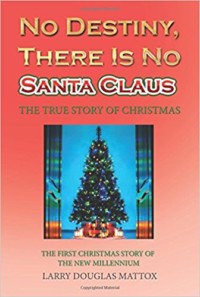Title: No Destiny, There Is No Santa Claus: The True Story Of Christmas
Author: Larry Douglas Mattox
Publisher: XlibrisUS
ISBN: 9781543417289
Pages: 300
Genre: Religion & Spiritual
Reviewed by: Carol Davala
Pacific Book Review
In the fall of 1897, eight-year-old Virginia O’Hanlon wrote to the New York Sun asking about the existence of Santa Claus. Journalist Frank Church’s spirited response about the “skepticism of a skeptical age” became a famous editorial renowned for the memorable line “Yes Virginia, there is a Santa Claus”, which is often reprinted during the holiday season. In Larry Mattox ‘uplifting No Destiny, There Is No Santa Claus: The True Story of Christmas, the same question is addressed, but now from a primarily religious point of view.
In this two-fold holiday narrative showcased as “The First Christmas Story of The New Millennium,” Larry Collins is prompted by his inquisitive daughter’s second-grade class assignment to share their family’s belief regarding Santa Claus and Christmas. A winter storm provides the perfect backdrop for a slice-of-life family drama. From shared secrets of good and bad news, to snow angels, church services and celebration dinners complete with football game banter, Mattox presents a close and positive family dynamic. Amidst relationship themes rooted in honesty and trust, the book is weighted by a biblical Christian timeline that Larry conveys to his daughter as an ongoing bedtime tale.
Here he embarks on a storytelling marathon detailing God’s creation of the universe, the devil as adversary, and man’s free will. From Adam and Eve’s temptations, to Noah’s Ark building, Moses and The Ten Commandments, snakes, plagues, parting seas and the death of thousands, the biblical journey is all encompassing. There is a rich character focus on many who became famous in the history of the Israelites. There are highlights of Samson and Delilah, the slaying of Goliath, temples destroyed and rebuilt, and the eventual return to the Promised Land. As a Christmas story, it’s interesting to note within the text there is no mention of the traditional nativity scene often associated with the holiday, nor suggestions of Jesus’ birth in a manger, surrounded by Mary, Joseph, or the three wise men bearing gifts. Instead we learn that Christmas translates as mass of Christ, and was originally observed on January 6th. With the triumph of Christianity throughout the world, this telling reveals Christmas replaced a pagan festival marking the winter solstice celebrated on December 25th.
Mattox takes a lengthy route to get to the heart of Santa’s existence. At times the historic diatribe seems so continuous readers may forget this is supposed to be a Christmas story. It also seems a bit implausible that a parent could hold a child’s attention for so long, or that they could retain so much information. Yet, back at school Destiny delivers a quality summation that speaks to the innocence and simplicity of childhood. She shines in her declaration “Our parents give us the gifts because God gave us his gift – the greatest gift, Jesus not Santa Claus. There is no Santa Claus.” It is here that Mattox effectively makes use of a culturally mixed classroom setting where a creative and astute teacher instills the ultimate lesson to both her young students and their parents.
While the book’s ending seems a bit abrupt, in its final moments we see this is not only a story about one family, but more importantly about the greater world community. Although Destiny’s father may contend that the jolly old elf in the red suit is merely a fictional creation embellished by European tradition, the deeper heartfelt message of cultural acceptance and religious inclusion resonates around us all in true Christmas spirit.


